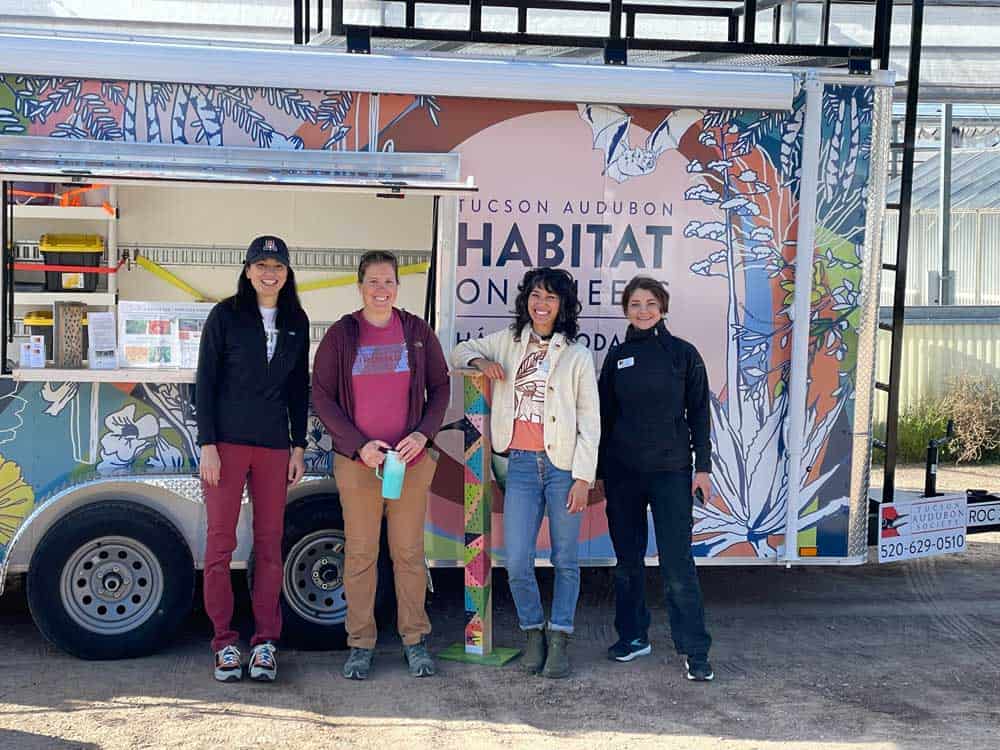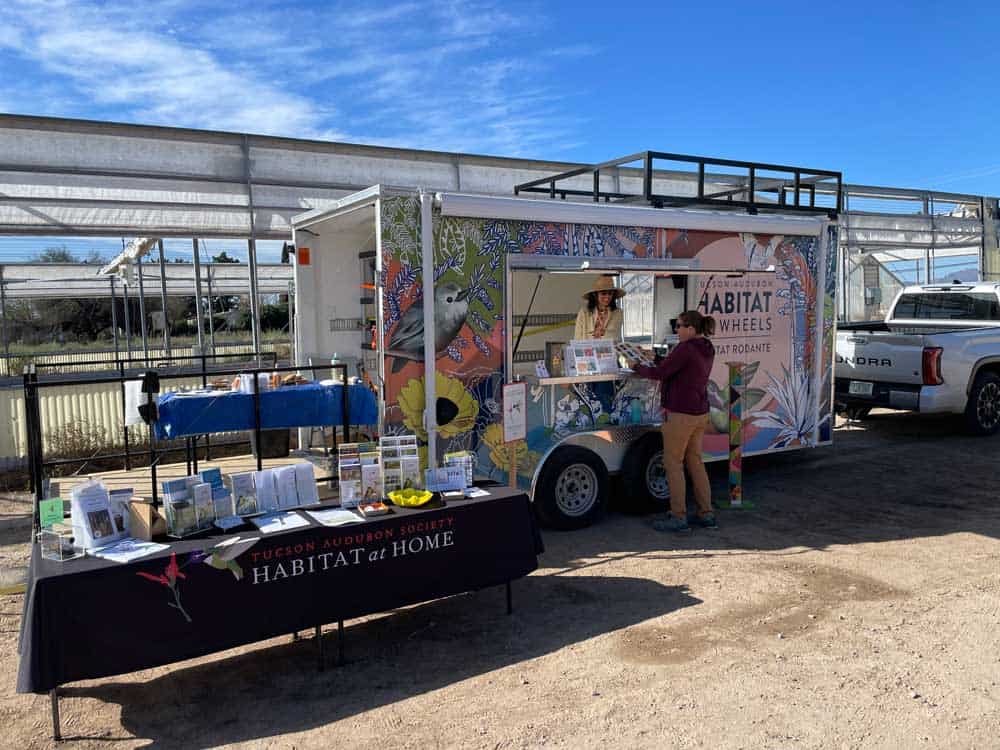Kim Matsushino is the manager of the Tucson Audubon Society Habitat at Home Program, which serves to assist and recognize homeowners in creating safe urban habitat for birds and pollinators. She is a native Tucsonan who grew up appreciating southeast Arizona’s wild lands with her family and dogs. Wanting to learn everything about the plants and animals she grew up with, she graduated from the University of Arizona with a degree in Conservation Biology and an affinity for birds.

Marshall Cutchin: I’ve heard your program described as making native plants more accessible to the community while creating more green spaces in areas affected by urban heat throughout Tucson. Tell us a little bit about how Habitat on Wheels got started and what it actually does.
Kim Matsushino: The Habitat on Wheels project started as a wild idea that came to me in the shower three years ago. I wanted to create a “native plant food truck” that would increase green space and habitat for birds and pollinators by giving away free plants in communities most impacted by urban heat.
In 2022, after a couple of declined grant proposals, we were awarded the 5 Star and Urban Waters Restoration grant from the National Fish and Wildlife Foundation and received generous donor support to launch the Habitat on Wheels project. We customized a 7’x16’ cargo trailer, retrofitting it into an eye-catching mobily display and outreach unit that is a beacon of environmental stewardship, hauling native plants and habitat-building resources to various local events, community centers, and neighborhoods.
Marshall Cutchin: What inspired you personally to want to start Habitat on Wheels? Did you grow up in the area? Are you a lifetime gardener or birder? Or did you start from having an interest in the social justice or urban planning aspects of what you are doing?
Kim Matsushino: I am a native Tucsonan and the product of two nature-loving teachers. My brothers and I grew up hiking, camping, and 4-wheeling all over Arizona and the southwest. I remember always wanting to know what everything was when exploring nature, whether it be a plant or insect. I think this strong connection with nature from a young age really shaped who I am today. Going into college, I, like many, wanted to be a doctor… until I took my first ornithology class. The field trips to local birding hotspots and learning how to identify birds through sight and sound got me hooked on birds and environmental science. I quickly changed my major to Natural Resources/Conservation Biology and never looked back.
You can’t have birds without plants and that has become abundantly clear as Tucson continues to grow and its natural areas become smaller and more fragmented. My work with the Habitat at Home program really sparked my joy of habitat gardening and personally experiencing the “plant it and they will come” phenomenon sparked it all the more. I want everyone to be able to experience the joy I had when that first hummingbird visited my yard. I want to help people to connect with nature and I want kids to grow up appreciating like I did.

Marshall Cutchin: You work pretty closely, I’m guessing, with the city of Tucson. Do they have particular programs that your initiative fits into? Is this something that you could see expanding to other cities?
Kim Matsushino: Absolutely. For the Habitat on Wheels project specifically, we have partnered with the City of Tucson’s Storm to Shade Program (Green Stormwater Infrastructure) and its Million Trees initiative. The city has also just launched a Turf Removal Rebate incentive, which our whole Urban Habitats Restoration Program will be involved with.
We’ve also partnered with both the city and county Parks and Recreation Departments and public libraries to provide free, urban birding field trips and birding kits for families that can be checked out at various library branches.
Marshall Cutchin: What surprises you most about the program? Is it having impacts or getting reactions you didn’t expect? Or is it turning out exactly as you expected and hoped?
Kim Matsushino: The biggest surprise for me is that this seemingly overarching food truck idea has come to fruition and that it turned out better than I imagined. We chose to have a local artist design the wrap for the trailer and I think that has had the biggest impact—you can’t not see it when it’s on the road or parked in a parking lot. Adding the names of the plants and animals to the artwork in English and Spanish has also had a significant impact and response.
The biggest challenge by far has been the plants. We planned on growing the plants to be distributed to cut down on costs, but with our unusually hot summer and fluctuating temperatures in the winter, it has been a challenge to say the least.
Marshall Cutchin: What are some of the native plants that you’re delivering to lower-income neighborhoods? What goes into choosing the species?
Kim Matsushino: We really want to have continued engagement with the communities we are working with, so we’ll be offering different plants each visit. With this approach, we hope to keep people coming back for new plant species which will ultimately provide better habitat for birds and pollinators.
We’ll be distributing plants that meet the criteria of being regionally appropriate, drought and sun tolerant, low maintenance and are beneficial to wildlife.
Species include: Chuparosa (Justicia californica), Desert marigold (Baileya multiradiata), Desert globemallow (Sphaeralcea ambigua), Penstemon (Penstemon parryi most likely), Fragrant bee bush (Aloysia gratissima), Milkweed (Asclepias subulata), and grasses (Muhlenbergia spp. and Bouteloua spp.)

Marshall Cutchin: When we spoke earlier, you joked that Tucson could use a “gravel removal program.” The same could be said of where I live in Colorado. But it is true that not all xeriscaping is created equal, is it?
Kim Matsushino: There are definitely some misconceptions about xeriscaping—what it is and what it is not. When done poorly, highly xeriscaped landscapes are just as bad as lawns in terms of the wildlife it serves. It’s barren, void of life, and increases surface temperatures.
However, xeriscaped landscapes can be quite beneficial. The main thing to avoid is using weed barriers which can cause the soil beneath to become compacted by limiting its nutrients, water, and air which is detrimental to the soil’s ecology. Adding rainwater harvesting basins and mulching around plants can help cool down the area while retaining moisture
Marshall Cutchin: What do you hope the impact will be of adding more locally appropriate and drought-tolerant plants to urban neighborhoods? Are there social impacts as well as environmental impacts that are worth calling attention to?
Kim Matsushino: There’s a tremendous correlation between the communities most vulnerable to extreme heat events and household income. Ultimately, everyone should have the opportunity to create sustainable green spaces to enjoy and learn from and that our local wildlife can thrive in without causing a financial hardship.
Marshall Cutchin: How can people in the Tucson area or maybe even elsewhere help you achieve your goals?
Kim Matsushino: If you’re in the area, please spread the word about the Habitat at Home program and the Habitat on Wheels project. We’ll be offering a sponsorship opportunity for the Habitat on Wheels project that will allow us to distribute plants to more communities—it will be posted on our website (tucsonaudubon.org/habitatonwheels).
I encourage everyone to learn about and plant natives (your local native plant society is a great place to start!) and to share your space with wildlife. It doesn’t take much to provide critical habitat for birds/pollinators. Dedicating as little as 1/8th of your outdoor space to urban habitat can make a huge difference. Most importantly, make your property safe for birds and pollinators. Make your windows visible to prevent window strikes, keep cats indoors, and eliminate/reduce pesticide use.
And of course, support your local nurseries! In Tucson, we are lucky enough to have Desert Survivors and Spadefoot Nursery, who not only sell great native plants but are extremely knowledgeable and helpful.
